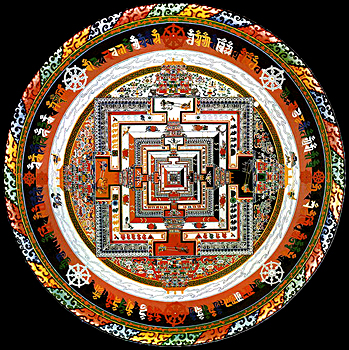 Kalachakrayana is perhaps the extreme phase of the Vajrayana with the predominanace of the terrible gods and goddesses. There is also the view that the Kalachakra system developed outside India before it came to be known in the land of Lord Buddha, in the latter half of the tenth century, during the reign of King Mahipala of Bengal. It was introduced into Tibet in 1026 A.D and into upper Burma in the 15th dentury. Two great scholars of the system were Tsilupa and Somanatha. The Kalachakratantra is the only available fundamental text of this system. Sometimes it has been claimed that the Kalachakra Tantra had been spoken by Lord Buddha at Dhanyakataka.
Kalachakrayana is perhaps the extreme phase of the Vajrayana with the predominanace of the terrible gods and goddesses. There is also the view that the Kalachakra system developed outside India before it came to be known in the land of Lord Buddha, in the latter half of the tenth century, during the reign of King Mahipala of Bengal. It was introduced into Tibet in 1026 A.D and into upper Burma in the 15th dentury. Two great scholars of the system were Tsilupa and Somanatha. The Kalachakratantra is the only available fundamental text of this system. Sometimes it has been claimed that the Kalachakra Tantra had been spoken by Lord Buddha at Dhanyakataka.
The concept of Kala or adibuddha, the primordial Buddha whence rises everything in the Universe is central to the system. `Kala` is the unchanging dharmadhatu, while the Chakra is the manifestation of time. The Kalachakrayanists attempts to keep himself above the influence of the cycle of time which is in constant motion, bringing about decay, death and re-birth. Time reveals itself in the flow of vital winds within the body which is the microcosm. An important concept of the Kalachakra is that in the body of man lie the Kalachakra or the Universe and the entire natural phenomenon. Kalachakra emphasises on Yoga as an important component.
The Kalachakryanists tries to stop the flow of winds and raise himself up to the state of mahasukha through sexo-yogic practices. Since Kala is the highest principle in this system they attach great importance to astronomical conceptions of yoga, karana, tithi etc and to the movements and positions of the sun, the planets and the constellations. They even interpret the various principles of Buddhism in terms of time and its different units. Thus the doctrine of Prtiyasamutpada is conceived as the movement of the sun through the twelve zodiac signs in twelve months. Further sunyata is thought of as the sun of the dark fortnight and karuna as the moon of the bright fortnight.
Thus, Kalachakrayana is a popular school of Tantric Buddhism and is greatly associated with mysticism.




















